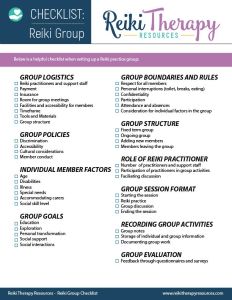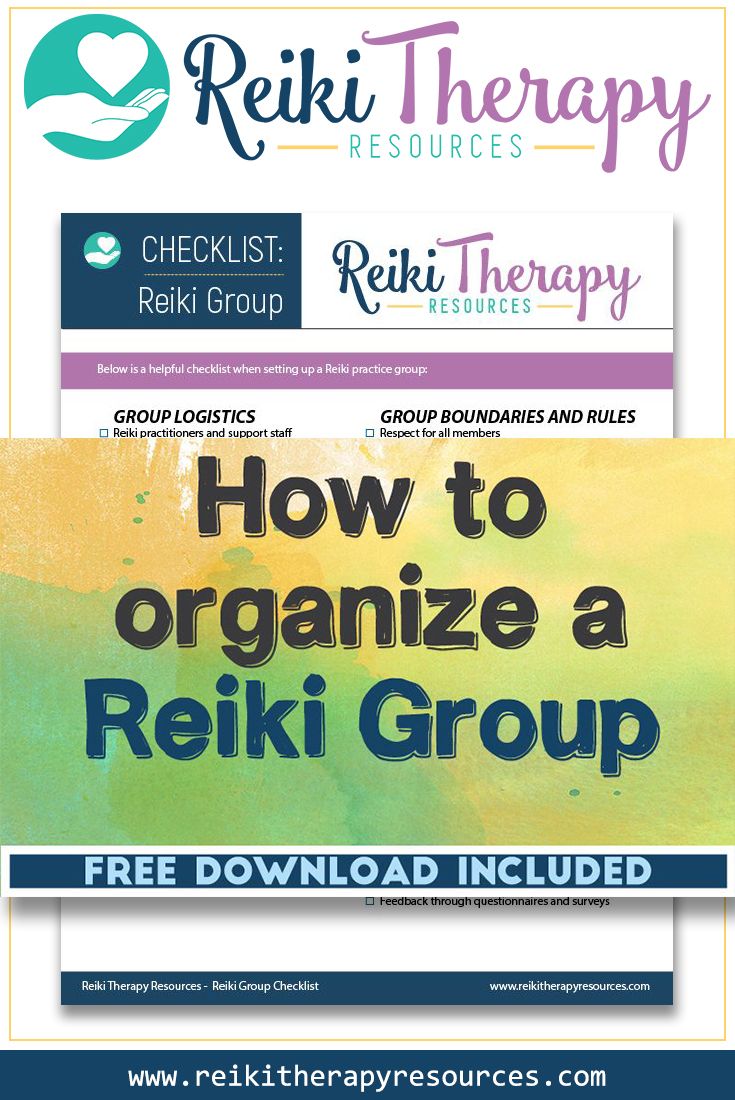
THIS POST INCLUDES:
——————————————–
1. What is a Reiki group
2. Benefits of a Reiki group
3. Organizing a Reiki group
4. Examples of a Reiki group
5. FREE DOWNLOAD Reiki Group Checklist
WHAT IS A REIKI GROUP
A Reiki group is designed to facilitate the process of using Reiki amongst peer Reiki practitioners. The group can be formed for a variety of reasons including collectively working on a single client or simply connecting with other practitioners to form a collective Reiki focused bond.
Often the dynamics of the group play a part in the healing process for the individual through shared experiences and group support.
Reiki Groups are also known by the name Reiki Circle. The circle refers to how the practice of Reiki is offered to each participant in the group circle.
BENEFITS OF A REIKI GROUP
Some common benefits for establishing a Reiki group are listed below:
- Facilitates community in a supportive environment through cooperation and communication
- Individuals with a shared belief in Reiki can provide support to each other
- Members can learn from the collective experience and feedback of other members
- Energy can be shared collectively based on the number of people in a group
- Individuals can feel empowered by developing and improving Reiki practice skills within the group
- Groups can defray concerns about focused attention on one individual. The individual can feel ‘safety in numbers’ while exploring their Reiki practice
- Groups can demonstrate fairness, sharing, and support through the rules of engagement
- Groups can provide an overall sense of community and reduce feelings of isolation
- Groups can increase an individuals exposure to diversity within a group of people and expand beliefs and assumptions about other people
- The presence of other members can inspire and motivate members to make personal improvements and transformations
Although there are many benefits to running an art therapy group, there are also some important factors to consider including:
- Ensuring confidentiality among a larger group of people
- Groups require more attention and resources to facilitate
- An individual member may feel hidden in a larger group
- Group dynamics may become stressful between individual members
- Some members may feel intimidated by other members of the group
All of these issues can be addressed by establishing group rules and paying attention to how individuals and the group as a whole are functioning.
ORGANIZING A REIKI GROUP
If you are considering running a Reiki group, below is a checklist of areas to consider when setting up your group:
- Group facilitator – who are the Reiki practitioners involved in the group. Define the roles of each facilitator and practitioner.
- Group schedule – define a suitable location and time.
- Group demographics – participant demographics and size of the group.
- Group goals – you may want to include generalized and/or specific goals such as focusing on a specific issue
- Group rules – define boundaries for confidentiality, respect for group members, and general social rules.
- Group session structure – general guidelines for introduction, Reiki practice, any discussions, and closing rituals.
- Group effectiveness – evaluation of the group progress compared to the goals that were originally established.
- Contingencies – establish contingencies for the practicalities of running the group such as change of location and time.
- Conflict – establish protocols for dealing with conflict between group members.
TYPES OF REIKI GROUPS
Some types of Reiki groups include:
- OPEN PRACTICE – the group works openly and collectively for each participant in a circle. The setting is informal and no themes or specific goals are established.
- GOAL ORIENTATED OR THEME BASED – the group meets to address specific issues or experiences such as grief, anger or divorce.
- SOCIAL ACTION GROUPS – this style is an extension of the theme based group style and focuses on a social issue that the group may be facing. Examples include asylum seekers, natural disaster victims, and religious groups.
REIKI GROUP SET UP CHECKLIST
Below is a helpful checklist when setting up a Reiki practice group:
- Group logistics including practitioners, payment, insurance, room, accessibility, facilities, timeframe, tools, and size of the group
- Group policies regarding discrimination, accessibility, cultural considerations, and member conduct
- Individual member factors – age, mental and physical disabilities, illness, learning difficulties, and special needs etc
- Establish the group’s goals
- Establish group boundaries and rules about behaviour and individual member respect
- Closed group with fixed members OR open group with ongoing addition of new members
- Role of the Reiki practitioner when interacting with the individual group members
- Group session format including introduction, Reiki practice, any discussions, and closing the session
- Recording group activities
- Evaluation group dynamics and achievements
ISSUES TO CONSIDER IN A GROUP
Some of the issues you need to consider in a group setting are the diversity of the group demographics. Demographic diversity refers to race, culture, gender, age, disability, health, and religion. From a social psychology point of view, individuals will connect with group members who best resemble their own demographic. This is evidenced by women’s groups, elderly groups, and religious groups that identify with like-minded individuals.
As individuals, we can benefit from exposure to other people with different backgrounds. When individuals with demographic differences gather together with similarities in circumstances, a bond can form that will help facilitate a healthy alliance between group members. This has occurred where communities have experienced a natural disaster such as floods.
While groups can serve as a space to broaden understanding and awareness, it is not the place to experiment with group dynamics and inquisitively observe the interactions of group members.
EXAMPLES OF REIKI GROUPS
Some of the most common Reiki groups are established based around the logistics and shared life experiences that present as a common theme within the group.
Examples of Reiki groups are:
- Aged care groups – focusing on maintaining memory, concentration, and achievement
- Health based groups – examples include breast cancer groups
- Institutional groups – school, prisons, hospitals, mental health facilities
- Issues based groups – dealing with bereavement, relationships
- Social issues based groups – examples include groups for refugees and collective groups experiencing a similar social issues
- General public – created for fostering community interaction and improving social cohesion
- Gender based groups – groups that focus on issues specific to gender
- Profession based groups – examples include groups for specific professions, eg, teachers, care workers, wellness workers, etc
FREE DOWNLOAD
SIGN UP below to receive your FREE DOWNLOAD. Once you enter your email address, you will receive access to the Free Reiki Group Checklist.

BUILD YOUR REIKI REFERENCE MATERIALS:
Pin this image to your Pinterest board.

SHARE KNOWLEDGE & PASS IT ON:
If you’ve enjoyed this post, please share it on Facebook, Twitter, Pinterest. Thank you!
